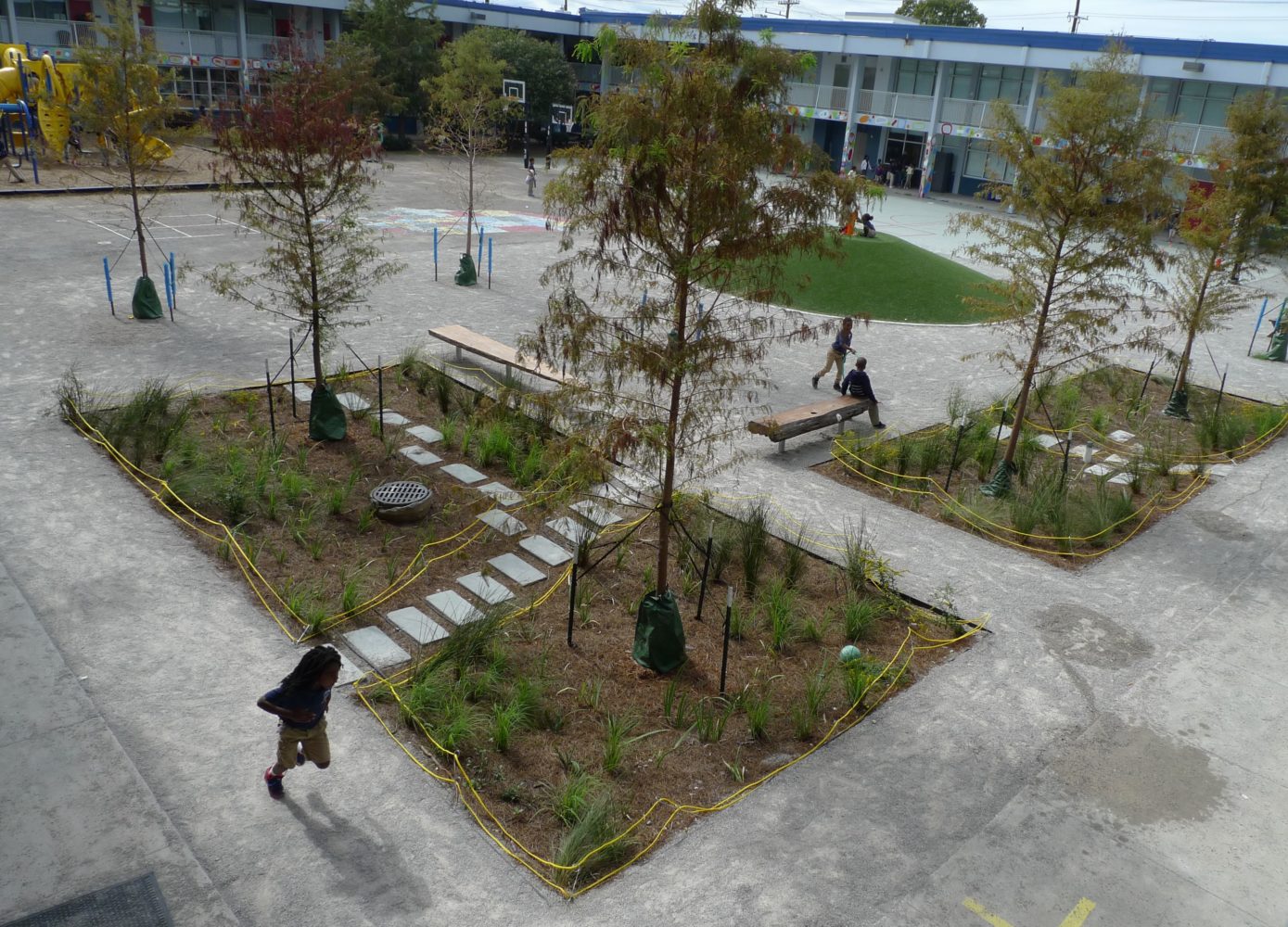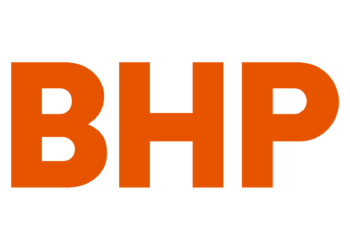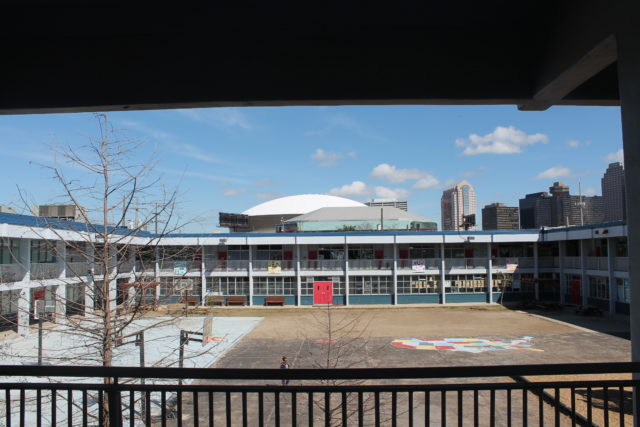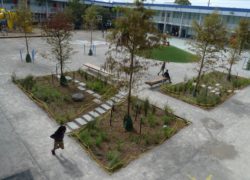Building Coastal Literacy
Younger Louisianans get a scientific grounding in how water shapes our coast
Published: August 30, 2019
Last Updated: May 13, 2020

Ripple Effect Water Literacy Project
The courtyard at KIPP Central City Primary after water-management improvements.
As part of the lesson, Anderson explained climate change’s effects on Louisiana. These days, she coordinates similar lessons across grade levels and school. Called Ripple Effect, the nonprofit effort helps teachers talk with students about topography, how water flows, and how sediment carried by the Mississippi River created the delta. They looked at maps and models showing how the land along the Gulf of Mexico is eroding, largely because sea levels are rising at the same time that Louisiana’s coast is slowly sinking.
Though the double whammy of sea-level rise and subsidence has been discussed among Louisiana scientists for decades and would become a basic tenet of the Greater New Orleans Urban Water Plan, the concept was a startling revelation for Anderson’s New Orleans class. Almost immediately, the schoolchildren understood that this was dire news for the bowl-shaped, levee-protected city they call home. One student, Kaliyah, raised her hand. “Why hasn’t anybody told us this before?” she asked.
Good question.
The language of the wetlands, hurricane season, and storm surge is familiar to generations of Louisiana residents, but most citizens receive little formal education on the topic. Now, a growing group of educators and nonprofit leaders are working to provide water literacy in an era where the effects of climate change threaten life as we know it in much of Louisiana.
Urban planners and everyday citizens began re-thinking how to live with water in the wake of Hurricane Katrina, thanks to key voices like architect David Waggoner, who led the team that facilitated two years of “Dutch Dialogues” workshops and studies that resulted in the 2013 Urban Water Plan. The next year, the Greater New Orleans Foundation (GNOF), began building upon the plan by taking leaders from local nonprofits and government agencies to Milwaukee, Austin, and Philadelphia to see how those cities successfully dealt with water through retention, protection, and drainage systems.
“Many Louisiana residents don’t have basic water and coastal literacy—it’s more complicated [here] than many areas of the country,” said Ella Delio, who directs environmental programs for GNOF and saw a pressing need for that education. “If we’re uninformed, we can’t make necessary changes to the coast.”
As Delio and her colleagues returned home from their travels, they began focusing on water-literacy programs that could reach a broad base of Louisianans: K–12 students and teachers, architects and urban planners, homeowners and policymakers. Much of the current ramp-up in water literacy across the state can be traced to GNOF’s efforts.
GNOF funding and expertise helped to launch K–8 water-literacy classes at FirstLine Schools in New Orleans, and they founded similar programming at the South Louisiana Wetlands Discovery Center in Terrebonne Parish. Now they’re funding the Coastal Teacher Fellowship program, a brand-new initiative led by the Louisiana Environmental Education Commission and Louisiana Department of Education to train twenty middle- and high-school teachers in teaching coastal literacy. For adults, especially architects, planners, and engineers, there are Urban Water Series lectures at night and technical master classes during the day.
From a broader perspective, teaching water literacy in tropical Louisiana illustrates the very power of science education itself. When done right, it breaks down lofty concepts into practical skills and common-sense questions that give everyone a better sense of the world around them.
“It’s an issue of translation,” said University of New Orleans sociologist Pam Jenkins. “You need to take complex terms about how flooding works and translate it into understandable terms for people.” Since Louisiana residents have practical, lived experiences about what water-literacy concepts have worked for them, that, too, needs to be acknowledged, Jenkins said. “You have to translate the experts to the community, but the community also needs to be translated to the experts.”
In 2013, Anderson co-founded Ripple Effect, which creates, tests, and provides teachers with standards-aligned science curricula to teach water literacy during the regular school day from kindergarten through 8th grade. State officials and other nonprofits have launched similar efforts to raise the levels of water literacy across Louisiana.
Water-literacy curricula call for hands-on, experiential lessons where students engage scientific phenomena and science and engineering practices to contemplate—and sometimes create—design solutions to environmental challenges. For example, several years ago, students contributed ideas to help redesign an interior courtyard at KIPP Central City Primary.
The courtyard is a central hub of Central City Primary. But its surface was packed dirt and asphalt, with no amenities for play, and it was uncomfortably hot on sunny days. When rain fell, the courtyard always flooded. So the students analyzed the area and recommended additions that might help make it more inviting and less flood-prone: lush green “rain gardens” that soak up water runoff, a giant play mound, native trees such as large cypress, and permeable surfaces such as soil and mulch that replaced the asphalt and allowed rainwater to soak into the ground instead of running off the surface.
To implement the student-design recommendations, the school launched a Kickstarter campaign and raised money from KIPP Central City Primary families and charitable foundations. The resulting school landscape resists flooding, because it captures the first half-inch of rainfall that falls into the yard.
Because climate change is happening swiftly, water-literacy education also needs to keep up with current events. So when the city of New Orleans experienced pump failures and widespread street flooding two years ago, Ripple Effect emailed a PowerPoint presentation called “Why does our city flood sometimes?” to hundreds of local schoolteachers and administrators, hoping to channel the curiosity of local children into a learning opportunity.
To address new state science standards that were adopted in 2017, the state Department of Education also works with the Louisiana Environmental Education Commission to develop Louisiana-specific “phenomena” that can be used in classroom lessons.
“Science education used to be about ‘knowing facts.’ Students memorized facts. But that is not science,” said Jill Cowart, director of math, science and STEM education for the Louisiana Department of Education. Cowart sees the new state standards as a welcome shift. They help to bring science to life and create more interactive learning for Louisiana’s science students, she said.
Phenomenon-based learning uses examples of science that students can observe in their own daily lives: a rising tide washing onto a coastal roadway, “ghost cypress” trees in a swamp that suffered salt-water intrusion, or a turtle found with a plastic ring around its neck. Students can then investigate, asking questions and finding solutions to real-world problems.
Part of the idea is that Louisiana’s younger generation will learn to live more compatibly with the water that surrounds us and will also gain practical skills to help them personally deal with issues like flooding.
Instructors also believe that arming today’s children with information now may provide broader solutions for all of Louisiana in future years.
“This is not a series of unsolvable problems,” Anderson said to her fellow teachers. “So who in your class will be the change we’re really looking for?”
Katy Reckdahl writes frequently for the New Orleans Advocate and works on specials for WDSU television. She has written for the Times-Picayune, New York Times, and Weather Channel.
 This article was made possible by the BHP-funded project, Coastal Impacts: An Integrated Approach for Community Adaptation, Understanding, and Planning, which will assist local communities to build intergenerational coastal literacy through community conversations around books, film, and exhibitions, fostering greater understanding of and support for coastal restoration projects.
This article was made possible by the BHP-funded project, Coastal Impacts: An Integrated Approach for Community Adaptation, Understanding, and Planning, which will assist local communities to build intergenerational coastal literacy through community conversations around books, film, and exhibitions, fostering greater understanding of and support for coastal restoration projects.

